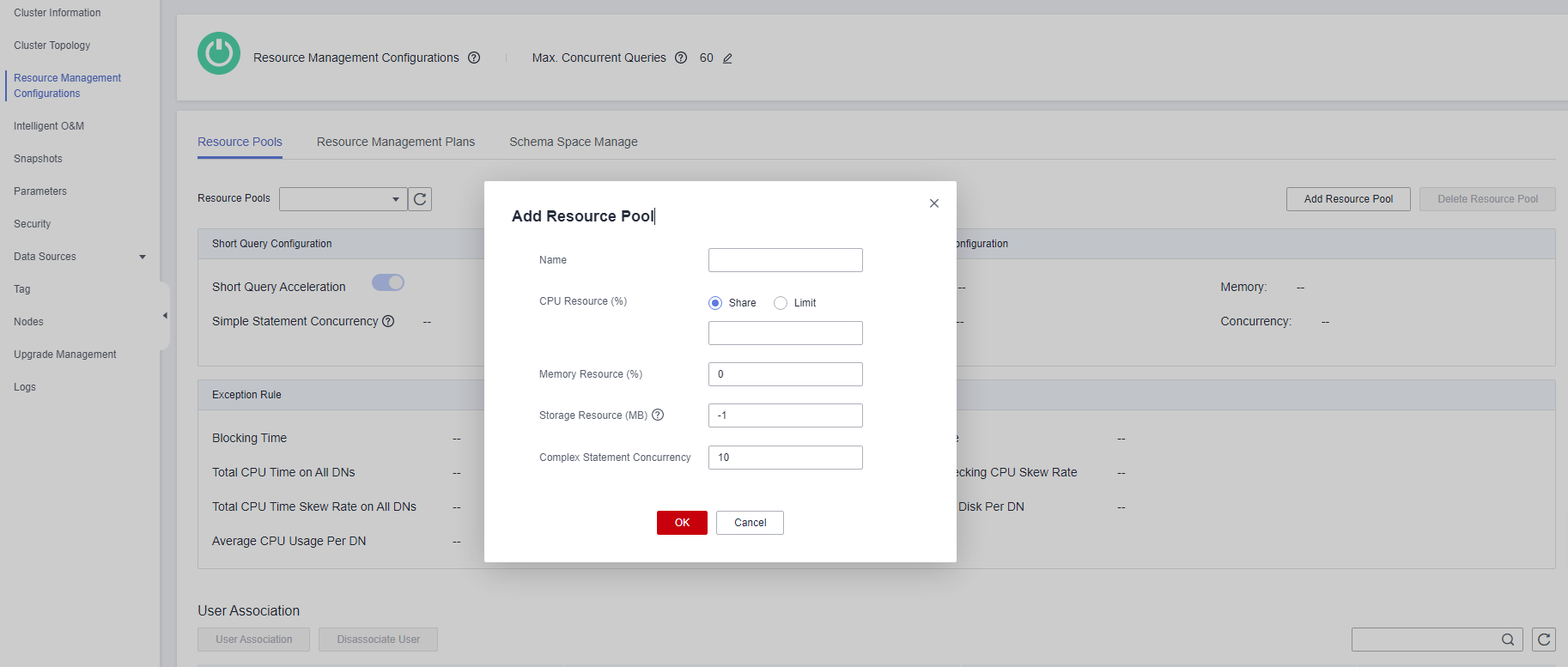GaussDB(DWS) CPU Resource Management¶
Overview of CPU Resource Management¶
In different service scenarios, system resources (CPU, memory, I/O, and storage resources) of the database are properly allocated to queries to ensure query performance, and service stability.
GaussDB(DWS) provides the resource management function. You can put resources into different resource pools, which are isolated from each other. Then, you can associate database users with these resource pools. When a user starts a SQL query, the query will be transferred to the resource pool associated with the user. You can specify the number of queries that can be concurrently executed in a resource pool, the upper limit of memory used for a single query, and the memory and CPU resources that can be used by a resource pool. In this way, you can limit and isolate the resources occupied by different workloads.
GaussDB(DWS) uses cgroups to manage and control CPU resources, involving the CPU, cpuacct, and cpuset subsystems. CPU share is implemented based on the CPU subsystem cpu.shares. The advantages of CPU share are as follows: CPU control is not triggered when the OS CPU is not fully occupied. CPU limit is implemented based on cpuset, which is a CPU subsystem used to monitor CPU resource usage.
When adding a resource pool on the GaussDB(DWS) management console, you should choose between Share and Limit.

CPU Limit¶
CPU Limit: specifies the percentage of the maximum number of CPU cores that can be used by a database user in the resource pool.
The limit has two meanings:
Dedicated: The CPU is dedicated to a Cgroup. Other Cgroups cannot use idle CPU resources.
Quota: Only the CPU resources in the allocated quota can be used. Idle CPU resources of other Cgroups cannot be preempted.
CPU limit is implemented based on cpuset.cpu. You can set a proper quota to implement absolute isolation of CPU resources between Cgroups. In this way, tasks of different Cgroups will not affect each other. However, the absolute CPU isolation will cause idle CPU resources in a Cgroup to be wasted. Therefore, the limit cannot be too large. A larger limit may not bring a better performance.
For example, in one case, 10 jobs are running on 10 CPUs and the average CPU usage is about 5%. In another case, 10 jobs are running on 5 CPUs and the average CPU usage is about 10%. According to the preceding analysis, although the CPU usage is low when 10 jobs run on five CPUs. However, CPU resource contention still exists. Therefore, the performance of running 10 jobs on 10 CPUs is better than that of running 10 jobs on 5 CPUs. However, it is not the more CPUs, the better. If ten jobs run on 20 CPUs, at any time point, at least 10 CPUs are idle. Therefore, theoretically, running 10 jobs on 20 CPUs does not have better performance than running 10 CPUs. For a Cgroup with a concurrency of N, if the number of allocated CPUs is less than N, the job performance is better with more CPUs. However, if the number of allocated CPUs is greater than N, the job performance will not be improved with more CPUs.
Application Scenarios of CPU Resource Management¶
The CPU limit and CPU share both have their own advantages and disadvantages. CPU share can fully utilize CPU resources. However, resources of different Cgroups are not completely isolated, which may affect the query performance. CPU limit can implement absolute isolation of CPU resources. However, idle CPU resources will be wasted. Compared with CPU limit, CPU share has higher CPU usage and overall job throughput. Compared with CPU share, CPU limit has complete CPU isolation, which can better meet the requirements of performance-sensitive users.
If CPU contention occurs when multiple types of jobs are running in the database system, you can select different CPU resource control modes based on different scenarios.
Scenario 1: Fully utilize CPU resources. Focus on the overall CPU throughput instead of the performance of a single type of jobs.
Suggestion: You are not advised to isolate CPUs between users. No matter which type of CPU control is implemented, the overall CPU usage is affected.
Scenario 2: A certain degree of CPU resource contention and performance loss are allowed. When the CPU is idle, the CPU resources are fully utilized. When the CPU is fully loaded, each service type needs to use the CPU proportionally.
Suggestion: You can use CPU share to improve the overall CPU usage while implementing CPU isolation and control when the CPUs are fully loaded.
Scenario 3: Some jobs are sensitive to performance and CPU resource waste is allowed.
Suggestion: You can use CPU limit to implement absolute CPU isolation between different types of jobs.